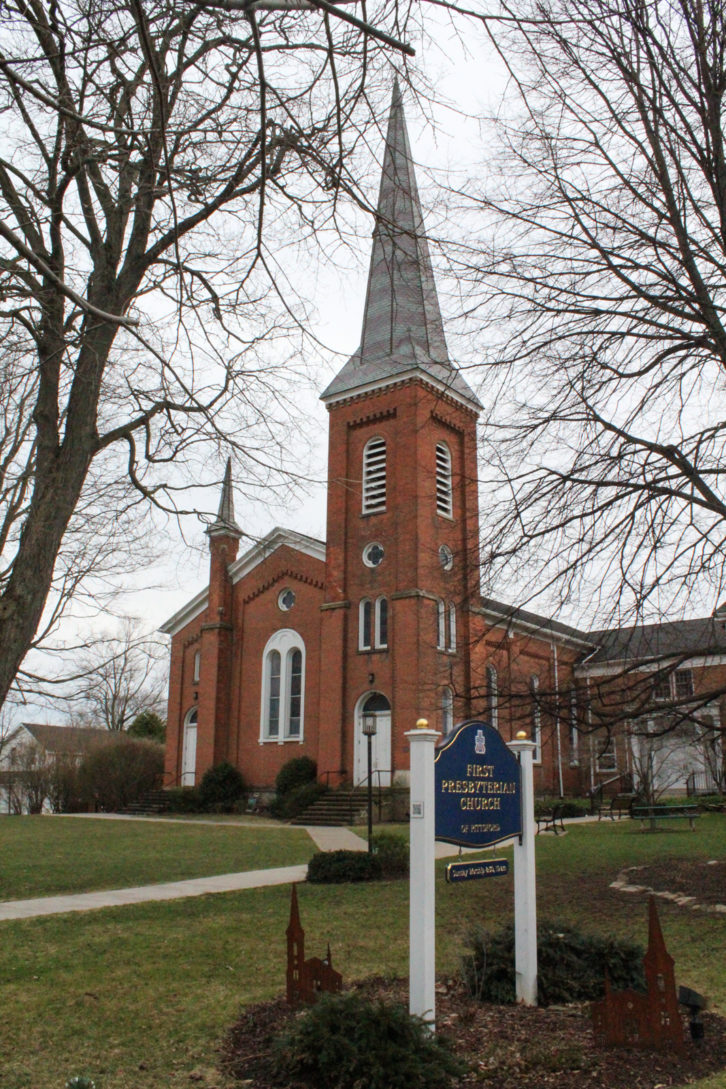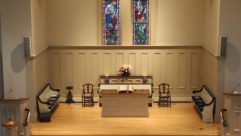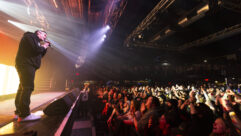 On this edition of the SVC Podcast, Contributing Editor Bennett Liles talks with Timothy Harris of TSH Audio & Visual about their sound system renovation for the First Presbyterian Church of Pittsford, New York. Timothy discusses the Martin Audio O-Line micro line array that he chose for the project and he details the process of removing the previous sound system and installing the new one.
On this edition of the SVC Podcast, Contributing Editor Bennett Liles talks with Timothy Harris of TSH Audio & Visual about their sound system renovation for the First Presbyterian Church of Pittsford, New York. Timothy discusses the Martin Audio O-Line micro line array that he chose for the project and he details the process of removing the previous sound system and installing the new one.
FOR MORE: GO TO PART 2
Links:
- TSH Audio & Visual in Syracuse, New York
- Martin Audio O-Line micro line array
- Labgruppen E-10:4 amplifiers
- Martin Audio DX4.0
- QSC Qsys core 110f
At the First Presbyterian Church in Pittsford, New York they needed better speech clarity for the pastor on the sound system. They also wanted video recording and streaming so they put TSH Audio and Visual on the job. Timothy Harris is here with all the details on how his outfit got the job done with O-Line arrays from Martin Audio. That’s up next on the SVC Podcast.
Timothy, thanks for joining us on the SVC Podcast from TSH Audio and Visual in Syracuse, New York. Good to have you here.
Yeah, thanks. Thanks for inviting me on.
We’ll be talking about a church sound system and video upgrade but first how about telling us about TSH Audio and Visual. What kind of company have you got there?
TSH Audio and Visual, we’ve been around for about five years. I kind of started out of the necessity in basically, upstate New York. Really we kind of go all over New York State and a lot in the northeast we’ve done some work. Really focused on the church market because up in this area there’s kind of a lack of a focused AV integrator that focuses on churches. So I saw that there was kind of a need so I started a company that we mainly focus on houses of worship. We’re a company the size of about six people that mainly just focuses on houses of worship. [Timestamp: 1:25]
You haven’t been in business that long but it looks like you’ve gotten out of the starting blocks pretty fast.
Yeah.
How did you get connected with the First Presbyterian Church in Pittsford, New York, the one we’ll be talking about on this one?
The First Presbyterian Church, we did do a small job with them back last year. They had a fellowship hall. Their whole system was all interconnected from their sanctuary to a couple other smaller rooms. And the main system over time, it just died. So they wanted to start with the fellowship hall to kind of get to know us and work with us and we were able to upgrade control and some video inputs in that small area which led us to work in their main sanctuary. The contractor that we use sometimes when we need to bring more people on for larger jobs kind of brought our name up and they reached out and contacted us, I think it was about spring last year – kind of seeing what their needs are. So we kind of joined together and we’ve gotten this far with them. And there’s some more work coming up in the near future to upgrade more of their rooms. [Timestamp: 2:27]
That’s always good. If you do a good job that’s the best advertisement for more work with that client.
Oh yeah, it’s always great.

So I read where this church actually got struck by lightning and burned down quite a few years back.
Yeah. I don’t know the full scope of it, but back in I think it was 2004 the main sanctuary, which I think dates back to the late 1800’s, I guess it was hit by lightning and it burned right to the ground. [Timestamp: 2:53]
OK, and since that happened I would think that they didn’t have any saved relics from the original sound system involved in this.
No, they did not. I really have no information on what the original sound system in 2004 was. They did the brand new building so when they did a brand new building they had another company design it and another company install it. And being relatively 16-17 years old, the system just started failing. So that’s why they kind of reached out to us to come in to update to newer technologies from now until the foreseeable future. [Timestamp: 3:27]
I guess a lot of it depends on what sort of congregation and worship style they have. Is this a church with more modern live music or does it have a more traditional congregation?
The congregation is very traditional. It’s a very older congregation. Hymnals – there’s no modern lights or praise band or anything like that. They have a very large pipe organ up in the choir loft that they use every Sunday, which is really a main focal point for the church so it’s very traditional. [Timestamp: 3:56]
I would think then, in this case the sound system design would have to stress speech clarity.
Yes. That was really the big point of the system we installed was speech intelligibility. Trying to keep it off areas that we didn’t want it to and kind of focusing more towards the audience area. [Timestamp: 4:12]
And how are the acoustics in that church? Was it a tall job getting a speech clarity sound system to work?
It’s very traditional, so putting up any sort of acoustical panels or anything was not going to happen. It’s a big rectangle room with a balcony up top which is the choir loft. There are some acoustical issues, but with the system that we designed with Martin we were able to focus all the energy right to where the audience is and keep it from hard avoid areas like the balcony front and the back walls. [Timestamp: 4:40]
And when you got into the design, what made the Martin Audio O-Line micro line array system the perfect one for this job?
First off it’s compact and it’s very slim and that’s what the church was looking for. They originally had two standard trap boxes hanging up in the air. They were very bulky and they’re very visual, so they kind of distracted from the art deco of the room – of all the molding and everything. So they wanted something that was a little bit smaller but had enough clarity and projection to get to the whole room without having large acoustical issues. With the O-Line and with the Martin DSP I was able to do that because with the Martin it’s almost like their larger MLA system. It’s all modular. I guess you could say it’s sort of their version of beam steering that you can steer the line array or the speakers into the area you want it to and keep unwanted noise off fronts of balconies and rear walls and sidewalls. [Timestamp: 5:44]
Yeah, they’re obviously not trying to blow the walls down or anything.
No, no. You’re lucky if they get over 90 decibels. It’s just for the pastor and some singing. We’re not getting into more modern worship levels. [Timestamp: 5:56]
I know a lot of the complaints in churches seem to be people saying they can’t hear so they just keep turning it up and it gets even more reverberant so what they’re actually complaining about is clarity.
Yes. You know with the larger older boxes, they worked but they just put so much energy all over the room without acoustical preparation for the room those boxes are just overbearing in that room. [Timestamp: 6:19]
And you used the Martin Audio DX4 speaker controller with this?
Yes, I did. So with that DSP – it’s a four in/eight out DSP. Martin uses what’s called resolution so it can be a one box, two box or three or four box resolution. With the Martin O-Line system with DX4.0, we’re able to put one resolution per speaker. So with less boxes per amp channel we were able to use the software more efficient to keep the audio into where the audience plane is instead of going like two-box resolution, which each resolution would be two boxes or three boxes. With the one resolution per box we’re able to really fine tune and focus the audio where we need it to be. [Timestamp: 7:10]
And to set that up and fine tune it I think you used the Martin Audio Display software.
Yes. We basically build the show in two dimension in Display software and we design it with walls and we put speakers where they should be. And then we put hard avoid areas – balcony, front, rear walls – in the software, which is really nice. And it processes a lot of information and it basically tells you put in a display angle and you’ll get audio from the front seat right to the back. And right after that it starts dying off pretty considerably at the back walls or front of balcony. The funny thing is, back in 2014 I took the MLA training out in Los Vegas before the Display was out to everybody, because now with the other line arrays they came out with, with the wave-front precision now, normal people can now use the software. Back then you had to be trained and only Martin will let people train to be able to use it. And they’re able to put a hole in the middle of the audience area where the audience dies down and 10 feet later it comes right back up by like 20 decibels, which to me, that was very impressive. And when they took that technology and brought it down to the O-Line, it was just a perfect marrying of a great technology for more traditional churches. [Timestamp: 8:29]
A real democratization of the software and setup capability.
Yes.
So let’s talk about the nuts and bolts part of this. When you actually got in there, what was involved in getting the old system out first? Did you have to run new cabling for all that?
With the original system, it was nice because everything was input in conduit. So the main trunk conduit was like a two-inch conduit. The AVL designer at the time wanted conduit with everything, which was great. So pulling cable wasn’t too much of a hassle. We did have to add some conduit to get speakers where they are now. Taking the old speakers down was just bring a lift in, rigging a couple of safety points down, taking them off and bringing them down. So really, tearing things out was not that complicated. Pulling wire, one of the tubes is pretty full so we had to kind of work with that a little bit, but it wasn’t really too hard to get everything where we needed to. [Timestamp: 9:24]
Well, that’s great so that by that time at least your crew isn’t already worn down…
Oh, yeah.
In time to start putting everything up.
Oh, yeah.
Where do they have the amplifiers and control point on this? I guess there’s not a lot of system controlling to do.
The amp rack is up on the second floor behind a wall on the other side from where the balcony is. So if you look right up where the balcony is and where the choir loft is and everything there’s a door to the left and you go through that and there’s a choir rehearsal room. The amp rack lives in its own room, which is probably eight feet by eight feet, which is a single rack in there. And all the wire comes in conduit right into there. [Timestamp: 10:01]
OK, and so do they have any kind of mixer or how do they control things?
The whole system is controlled off of a QSC Q-SYS system. There’s no physical mixer. Everything is either controlled from a touch panel at the podium down at the front of the stage, which had basically some controls of turning mics on and the system on and off, turning projectors on and off. If you want to get more depth there’s a screen on the front of the rack which gets into more of the video routing, microphone mutes and unmutes and gain for each mic. And there’s also a iPad app which mirrors that touch panel on the front of the rack to help them do basically the same thing if they need to do a little bit more tweaking, camera control and all that. [Timestamp: 10:48]
Well, that’s a great idea keeping it simple since their needs are fairly simple. No point making it any more complicated than it has to be.
Yeah. Yeah. I mean the whole system is controlled by QSC Q-SYS – projectors on and off, camera control. We’re waiting on an update to their network so we can have full control with a touch panel or a iPad app of their streaming service, which they just – they hit a button and it streams and it turns it on and off. [Timestamp: 11:13]
We’ll be talking more about that in Part 2 and get more into the video side of this thing but nice hearing about how you got the original system out the Martin Audio O-Line system in. This has been Timothy Harris of TSH Audio and Visual in Syracuse, New York. Talking about the sound and video system upgrade at the First Presbyterian Church in nearby Pittsford in the Rochester area. We’ll get you back in Part 2.
All right. Thanks.
So now the First Presbyterian Church in Pittsford has the speech clarity and video streaming they need with a very simple pushbutton system. Next week Timothy will give us the lowdown on the video streaming and projection for the church, right here on the SVC Podcast. See you then.










